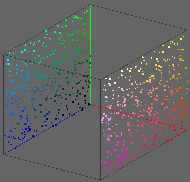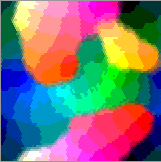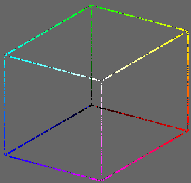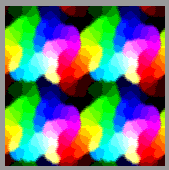

The input is two two-dimensional continuous regions separated by a
large discontinuity in the third dimension.
The output has two regions separated by a discontinuity.
The two continuous regions appear to be a continuous deformation of
the black-blue-green-cyan and red-magenta-yellow-white surfaces from
the input.


The input consists of one-dimensional lines on the edges of the color
cube, intersecting in triples at the corners. In the output image,
we see regions of continuous color bounded by discontinuities.
Notice that of the twelve edges in the input, only one was not preserved,
the one from white to yellow. This image then represents an unsuccessful
run of the network.
I have observed the network correctly completing
this mapping by exploiting the toroidial (wrap-around) nature of the
output space, giving a map something like this:

